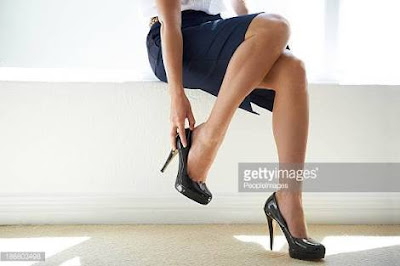 |
British researchers say evidence suggests both women and men find those in heels more appealing.
Almost two-thirds of business women think high heels make them more attractive a boost to self-image, confidence and general well-being.
Men are almost twice as likely to smile at a woman in heels than one in flats, and are significantly more likely to offer her help.
There’s some good evidence that when ladies walk in a high heel shoe, there is increased pressure on the front part of the foot,” Associate Professor Lloyd Reed from the QUT School of Clinical Sciences in podiatry told The Huffington Post Australia. “Particularly under the big toe joint, the first metatarsal.
“A lot of weight gets shifted over to the front there, and there is less pressure out near the little toe.
“The types of problems that we see, is something like a bunion on the big toe joint, or hallux valgus.
“Other problems can include corns and calluses on the feet, especially under the ball of the foot and then on the tops of the toes. The pain under the ball of the foot is called metatarsalgia. There is also something called plantar fasciitis which some people would refer to as ‘heel spur syndrome’ which is pain directly under the heel.”
But the same academics also point out that the shoes cause back pain, broken ankles and sprains, and more than double the risk of developing bunions.
They add that women who wear heels can suffer injuries from their toes up to their spine, and are more likely to fall. The scientists even go so far as to say that tougher laws are needed to stop women being forced to wear high heels at work against their will.
The findings follow high-profile complaints from women told to wear heels as part of their job.
If these aren’t gnarly enough to make you reconsider your high heel addiction, take into account what Reed refers to as Haglund’s Deformity.
“That’s a bump on the back of the heel which can be quite painful when ladies are wearing their dress heels or court shoes,” Reed said. “It may be associated with using high heels for prolonged period.”
“There have also been a couple of studies done which look at swelling in the ankles and feet and the legs, and they have found there is an increase in swelling as a result of standing in high heel shoes compared to standing in low heel shoes,” Reed continued.
“That’s because there’s a reduction in the efficiency of the calf muscle pump which should pump the blood and the fluid back toward toward the heart. But because it doesn’t work as well in high heels, it creates pressure in the veins.
“So as far as your legs are concerned, you’re going to stretch out the muscles in the front, tighten and shorten the muscles in the back and you’re going to cause the legs and the ankles to swell.”
Not that pain is going to stop women from wearing heels any time soon. As Reed points out, one American study found 42 percent of women wore high heels in spite of pain for aesthetic reasons.
A team at Aberdeen University reviewed 20 publications on high heels to find the high risk of injury and musculoskeletal pain. The results are published in the journal BMC Public Health. Lead author Dr Max Barnish said: ‘There is pressure on women to wear heels, and celebrity influence with people such as Victoria Beckham and Kate Middleton making it fashionable to do so, whether they intend to or not.
There is often not an absolute rule to wear heels, but in some workplaces there can be an unspoken expectation which means that everyone does it.
Evidence shows women are suffering ankle fractures and sprains, back pain and bunions. But they are judged to be attractive, which creates a dilemma.


Leave a Reply